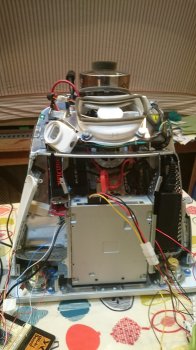Oh wow!
This is Stephen Ferris, the guy who did the mod with the grape tray loading iMac! I’m really excited about this as I also have a lime green iMac DV that I’d like to do. I started trying at one point but realized it was a lot more complex than the tray loader, so I gave up.
Sadly, my trayloader eventually stopped working because the power supply wore out. They only have 80 watts, and are known to wear out even with the original G3 logic boards. From what I understand, the slot loaders have 150 watts, which should be enough for most itx boards.
One thing I like about going the hackintosh route is that you can enter the original serial number of the iMac, and it will recognize it as an iMac G3 in About This Mac. On my main hackintosh in a digital audio G4 case, I even called Apple and gave them the serial number so I could use Messages and what not. I told them I “upgraded” the G4 to run Yosemite, and they were really impressed, lol.
This is Stephen Ferris, the guy who did the mod with the grape tray loading iMac! I’m really excited about this as I also have a lime green iMac DV that I’d like to do. I started trying at one point but realized it was a lot more complex than the tray loader, so I gave up.
Sadly, my trayloader eventually stopped working because the power supply wore out. They only have 80 watts, and are known to wear out even with the original G3 logic boards. From what I understand, the slot loaders have 150 watts, which should be enough for most itx boards.
One thing I like about going the hackintosh route is that you can enter the original serial number of the iMac, and it will recognize it as an iMac G3 in About This Mac. On my main hackintosh in a digital audio G4 case, I even called Apple and gave them the serial number so I could use Messages and what not. I told them I “upgraded” the G4 to run Yosemite, and they were really impressed, lol.




